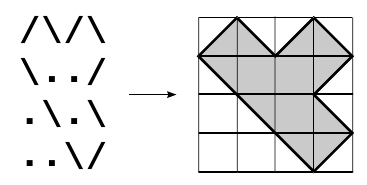
Long time ago, most of PCs were equipped with video cards that worked only in text mode. If the programmer wanted to show a picture on a screen, he had to use pseudographics or ASCII art like this:
^..^ (OO) / \ ()()
In this problem you are given a polygon, drawn using ASCII art.
Your task is to calculate its area. The picture is formed using
characters `.', `\', and `/'. Each character
represents a unit square of the picture. Character `.'
represents an empty square, character `/' -- a square with
a segment from the lower left corner to the upper right corner,
and character `\' -- a square with a segment from the upper
left corner to the lower right corner.

The first line of the input file contains integer numbers h and w
(2![]() h, w
h, w![]() 100) -- height and width of the picture. Next h lines
contain w characters each -- the picture drawn using ASCII art.
100) -- height and width of the picture. Next h lines
contain w characters each -- the picture drawn using ASCII art.
It is guaranteed that the picture contains exactly one polygon without self-intersections and self-touches.
Print to the output file one integer number -- the area of the polygon.
4 4 /\/\ \../ .\.\ ..\/
8